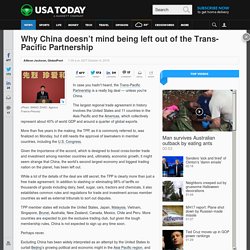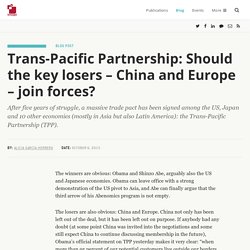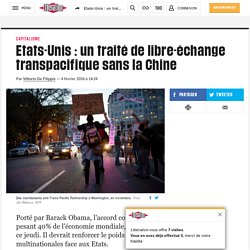Zoom
Trash

Why China doesn’t mind being left out of the Trans-Pacific Partnership. In case you hadn’t heard, the Trans-Pacific Partnership is a really big deal — unless you're China.

The largest regional trade agreement in history involves the United States and 11 countries in the Asia Pacific and the Americas, which collectively represent about 40% of world GDP and around a quarter of global exports. More than five years in the making, the TPP, as it is commonly referred to, was finalized on Monday, but it still needs the approval of lawmakers in member countries, including the U.S. Congress. Given the importance of the accord, which is designed to boost cross-border trade and investment among member countries and, ultimately, economic growth, it might seem strange that China, the world’s second largest economy and biggest trading nation on the planet, has been left out. While a lot of the details of the deal are still secret, the TPP is clearly more than just a free trade agreement. Perhaps never. But does Beijing really care? Read or Share this story:
Leaving China out of the TPP is a terrible mistake. © Time Inc.

All rights reserved. Fortune.com is a part of the Time.com network of sites. Powered by WordPress.com VIP Email address or Password is incorrect Forgot Password? Want the Full Story? Privacy Policy Thank you for your interest in licensing Fortune content. Trans-Pacific Partnership: Should the key losers – China and Europe – join forces? After five years of struggle, a massive trade pact has been signed among the US, Japan and 10 other economies (mostly in Asia but also Latin America): the Trans-Pacific Partnership (TPP).

The winners are obvious: Obama and Shinzo Abe, arguably also the US and Japanese economies. Obama can leave office with a strong demonstration of the US pivot to Asia, and Abe can finally argue that the third arrow of his Abenomics program is not empty. The losers are also obvious: China and Europe. China not only has been left out of the deal, but it has been left out on purpose.
If anybody had any doubt (at some point China was invited into the negotiations and some still expect China to continue discussing membership in the future), Obama’s official statement on TPP yesterday makes it very clear: “when more than 95 percent of our potential customers live outside our borders, we can’t let countries like China write the rules of the global economy”. Republishing and referencing. Etats-Unis : un traité de libre-échange transpacifique sans la Chine. Barak Obama n’aura pas attendu une minute de plus.

Jeudi, aussitôt signé l’accord en Nouvelle-Zélande du partenariat transpacifique créant la plus vaste zone de libre-échange au monde, le président des Etats-Unis s’empressait de déclarer : «Le Trans-Pacific Partnership [TPP, ndlr] permet aux Etats-Unis de rédiger la feuille de route du XXIe siècle, ce qui est particulièrement important dans une région aussi dynamique que l’Asie-Pacifique.» Une manière de dire au reste du monde, mais surtout à Pékin, que le XXIe siècle sera américain et non chinois. Le partenariat transpacifique (PTP en français) entre les Etats-Unis et onze pays du Pacifique a été conclu après une dizaine d’années de laborieuses discussions. Certes, il reste encore deux ans pour dépasser le cap des Parlements et autres Congrès des douze pays signataires qui devront ratifier ce traité. «Priorité aux salariés américains» TPP «jamais dirigé» contre un pays Vittorio De Filippis. What China will have to do to join the Trans-Pacific trade club — Quartz.
Twelve countries have reached agreement on the Trans-Pacific Partnership, arguably the world biggest-ever free trade deal.

It marks a watershed pact that could open up trade between the United States, its allies, and many Asian countries. But one Asian country is conspicuously missing: China. That might not last. Barack Obama has at times framed the partnership, or TPP, as an effort to set free trade standards in Asia before China does. But China isn’t completely averse to signing on, as Obama has himself acknowledged. Joining the TPP would require China to change old habits, even those it has kept after joining the World Trade Organization (WTO) in 2001. Change tariff policies One of the US’s stated objectives in proposing the TPP is to reduce tariffs on imports of agricultural products, textiles, electronic machinery, plastics and chemicals, and other types of goods. It’s true that China has steadily reduced tariffs on imports of some foreign goods, like diapers and skincare products.